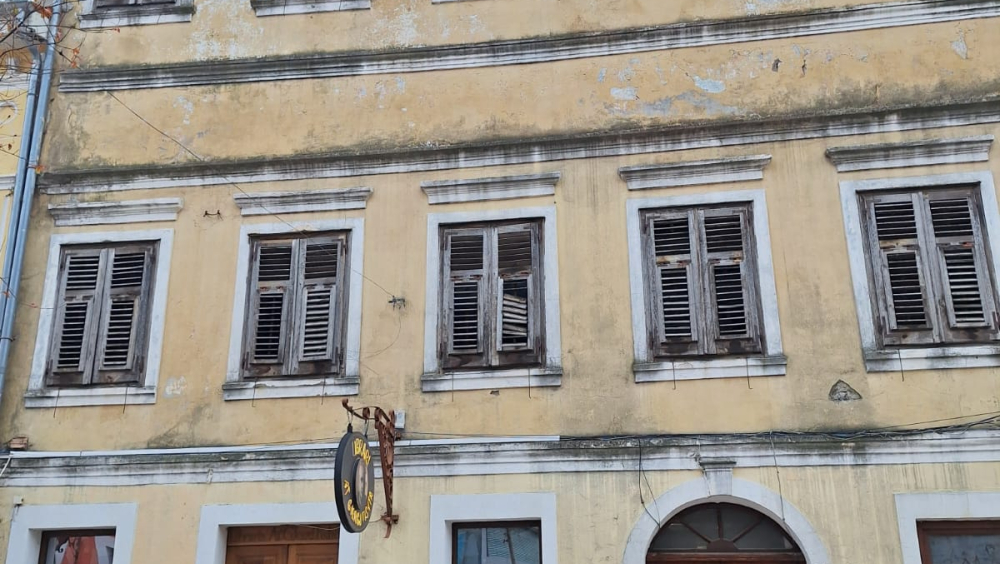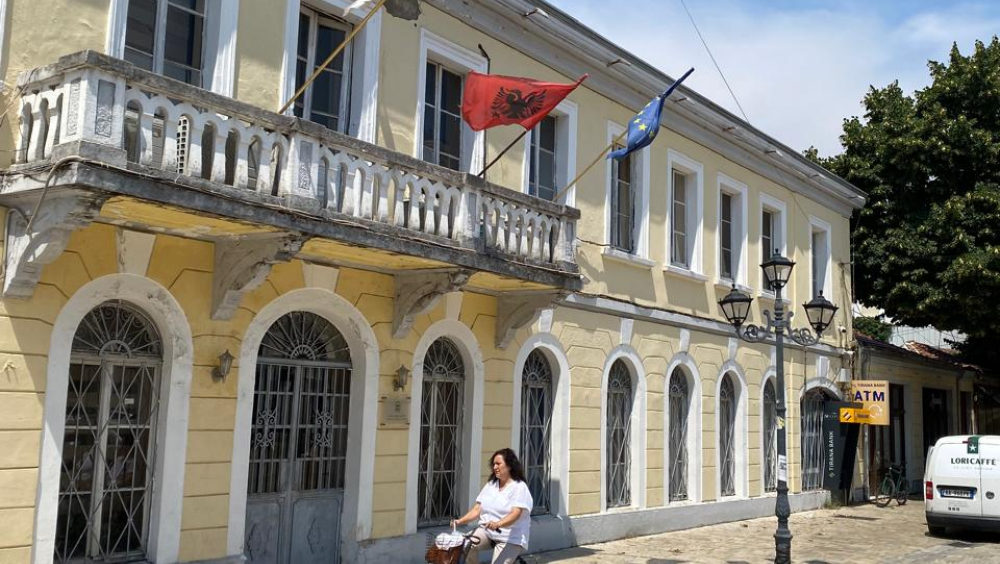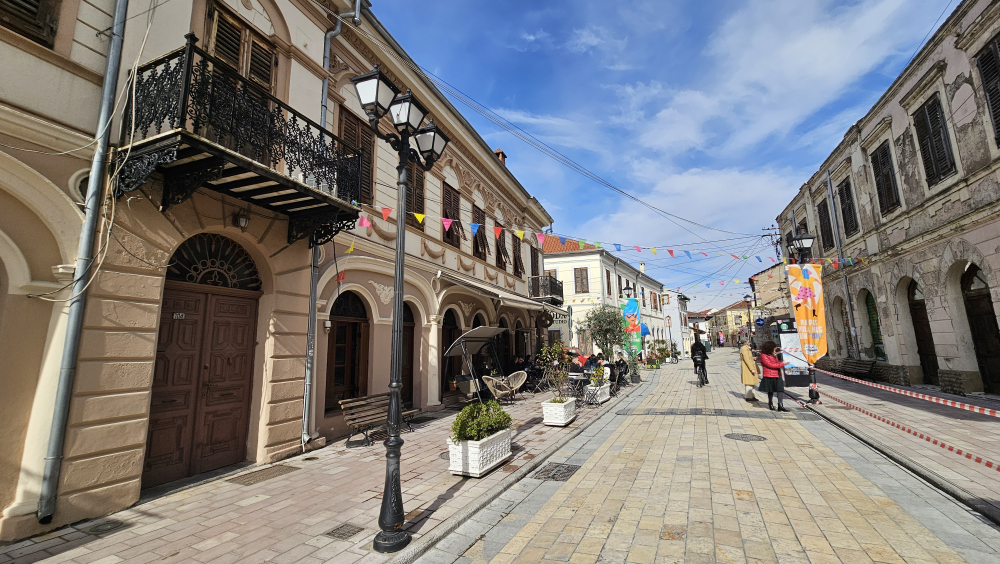The journey of Kol Idromeno
At the turn of the 19th century, Shkodër was alive with change. Its cobbled streets, traditional houses, and vibrant culture were entering a new era—one shaped by the National Renaissance. In the heart of this transformation stood a visionary artist: Kolë Idromeno.
Known for his paintings and photography, Idromeno was also a pioneer in architecture. For him, buildings were more than structures; they were a fusion of tradition and modernity, carrying the soul of the city. His home in Gjuhadol was not just a residence—it was a manifesto. Large windows flooded the space with light, blending functionality with beauty. Here, he painted, captured the city through photography, and even introduced one of Shkodër’s first film projections.
But his impact extended far beyond his home. When tasked with designing Shkodër’s Cathedral, Idromeno saw it as more than a place of worship. He envisioned a landmark that harmonized European neoclassicism with local tradition, creating one of the city’s most enduring monuments. His architectural projects shaped the urban landscape, ensuring that every structure was not just strong and functional but aesthetically meaningful.
Today, as Shkodër evolves, Idromeno’s influence remains. His work reminds us that architecture is not just about construction—it is about preserving identity, fostering community, and blending past with future. Walking through the streets of Shkodër, one can still feel his presence in the facades, balconies, and timeless elegance of the city—a silent testament to a man who saw his hometown as a living masterpiece.
At the turn of the 19th century, Shkodra was a city buzzing with new ideas. Along its cobblestone streets, nestled between buildings with sloping roofs and small shops, the waves of a new era could be felt. It was the time of the National Renaissance, a period when culture, art, and architecture were undergoing a profound transformation. At the heart of this shift stood a man with an extraordinary vision—Kolë Idromeno.
Widely recognized as a painter and photographer, Idromeno had another passion often left in the shadows—architecture. Not just as a profession, but as a mission to raise his city to a new aesthetic and functional standard. And in this journey, architecture and visual art intertwined in a unique way, culminating in a breakthrough that would forever change Shkodra’s relationship with the moving image: cinema.
In the heart of the city, on the streets of Gjuhadol, where the history of the city was etched in every stone, Idromeno built his home. But this was no ordinary dwelling; it was an architectural manifesto. Inspired by a simple yet elegant style, the building harmoniously fused tradition and innovation. The large windows allowed light to penetrate the interior, creating a soft and poetic atmosphere—an essential element for someone who saw the world as a living painting. But Idromeno's house wasn’t just a place to live. It was an experimental laboratory for art and technology. It was here that some of his most important paintings were created, where the first photographic images documenting the city and its people were captured, and, above all, where a new connection with an unfamiliar medium—cinema—began to take root.
Idromeno had a sharp eye for the image. He began with photography, an art form that not only captured reality but elevated it to a new artistic dimension. The people who passed through the threshold of his home entered a different world. They were no longer simply spectators of paintings hanging on the walls, or photographs capturing moments of life in Shkodra; for many of them, this was their first encounter with a film—an experience that would forever alter the way they perceived the world.
As the years passed, Shkodra would become an important center for development, and Idromeno didn’t stop there. He didn’t view architecture merely as an aesthetic exercise; he saw it as a tool to transform the city. Walking through the streets of Shkodra, he imagined a city where tradition and modernity could coexist—where buildings were not just functional, but beautiful.
When he was entrusted with designing the Cathedral of Shkodra, Idromeno understood the immense responsibility on his shoulders. A building like this was more than just a religious structure; it was a symbol of the city, a reference point for future generations. With a style inspired by European Neoclassicism but with an approach that respected the location where it was being built, Idromeno created a magnificent structure that would become one of the most important monuments in Shkodra. Meanwhile, he continued to work on other homes, influencing the city’s architecture with every new project. He experimented with forms and materials, using stone and wood in innovative ways, always ensuring that his buildings were not only strong and functional but also aesthetically pleasing.
As the years went by, Idromeno's vision remained alive. Today, as we walk through the streets of Shkodra, we still feel his influence. In the façades of houses with intricately carved balconies, in the large windows that reflect the sunlight, in the sense of a city that has preserved its spirit despite the changes of time.
His buildings are not just physical structures; they are part of a story that continues to tell of a man who saw beyond what was conventional, a man who viewed his city as a work of art. In every stone carefully placed, in every line thoughtfully drawn, lies the legacy of an artist who made Shkodra more beautiful—not only with his paintings and photographs but also with the buildings he left behind.
And so, as the afternoon sun falls over the old streets of Gjuhadol, the shadows of Idromeno’s architecture continue to speak. They tell the story of a city that was shaped by art, by the vision of a man who understood that architecture is not merely construction—it is a way of living, of creating, and of dreaming.
Today, in an era where Albanian cities face rapid urban development, Idromeno’s buildings remain a clear example of what it means to build with vision. He didn’t just design for the present; he created spaces that would have meaning and value for future generations.
In a time when modern buildings often lack character and a connection to their historical context, Idromeno’s architecture reminds us that development need not be at odds with tradition. On the contrary, it should be built upon it, carefully respecting and transforming it.
The restoration and preservation of his buildings is not merely an effort to protect something old. It is an effort to preserve an identity, a way of life, a philosophy that places the human being at the center of architecture. In a world where public spaces are being reduced and buildings are becoming more isolated, Idromeno’s legacy reminds us of the importance of structures that connect people to each other and to their city.
If architecture is a language, then Idromeno’s buildings continue to speak. They tell us of a time when art, technology, and urbanism met to create a new Albanian identity. They remind us of a man who refused to be confined by the norms of his time, who dared to experiment, innovate, and create.
At the crossroads of the 19th and 20th centuries, Albania was undergoing a profound transformation, shaped by the ideals of the National Renaissance. In this dynamic period, Kolë Idromeno emerged as a pioneering figure whose work in architecture, painting, photography, and sculpture reflected the spirit of European modernity. His artistic and architectural contributions were deeply influenced by European movements, making him not only a national icon but also a key figure in the shared cultural heritage of Europe.
Idromeno’s architectural vision embodied the core values of European heritage: humanism, innovation, and cultural exchange. Educated in Venice, he absorbed the principles of European classicism and modernism, which he seamlessly integrated into the urban fabric of his hometown, Shkodër. His designs—such as the Shkodër Cathedral—blended neoclassical European aesthetics with local traditions, symbolizing the dialogue between regional identity and pan-European influences.
Beyond architecture, Idromeno was instrumental in introducing new artistic and technological advancements to Albania. His early adoption of photography documented everyday life, preserving social and historical narratives in alignment with the European tradition of visual storytelling. He was also among the first to introduce cinema to Albania, reinforcing his role as a bridge between European artistic movements and local cultural development.
His work reflects the core democratic ideals upheld by the Council of Europe: the right to cultural expression, the preservation of heritage, and the promotion of shared European identity. Through his architectural and artistic legacy, Idromeno contributed to the values that underpin European integration—demonstrating how cultural heritage can foster mutual understanding across borders.
By celebrating Idromeno’s legacy at a European level, we highlight the interconnectedness of our histories and the enduring relevance of cultural heritage in shaping a more inclusive, democratic, and diverse Europe.


